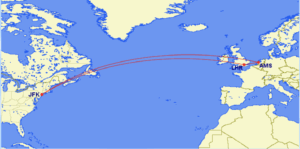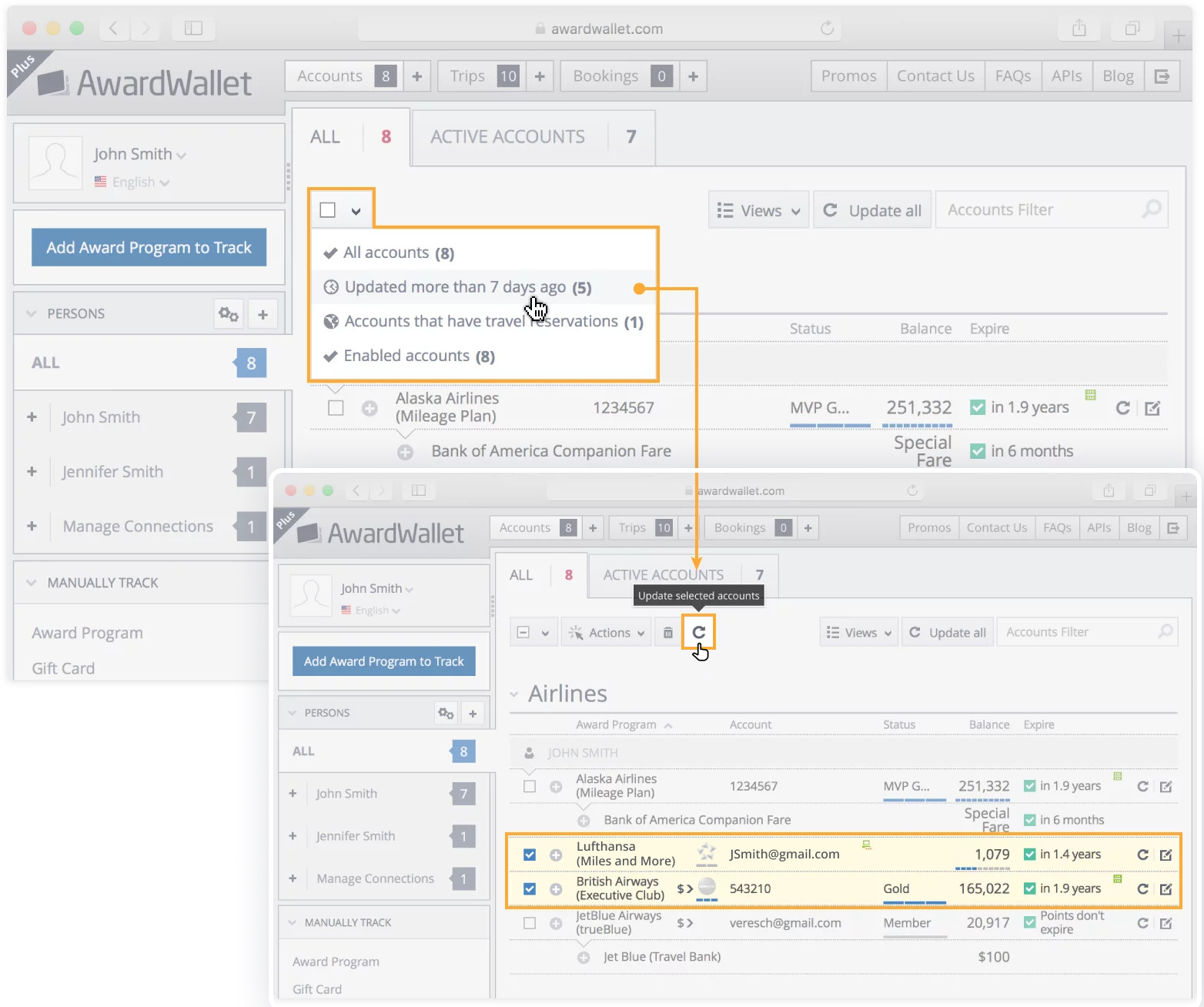AwardWallet receives compensation from advertising partners for links on the blog. The opinions expressed here are our own and have not been reviewed, provided, or approved by any bank advertiser. Here's our complete list of Advertisers.
The terms “layover” and “stopover” are often used interchangeably. However, while both refer to the amount of time between flights, the terms mean two different things.
These two words can have a significant impact on the options available when booking a flight with miles, so it's important to understand the difference. What's the difference between a layover and a stopover, and how could these impact your travel options? Let's take a look.
Page Contents
What is a Layover?
Generally speaking, a layover is a period of time between flights that is less than four hours for domestic travel and less than 24 hours for international travel. Some airlines define these periods differently, but this is the most commonly used timeframe.
Related: How Many Miles Do You Need for a Free Flight?
What is a Stopover?
In simple terms, a stopover just means a long layover. This is usually defined as longer than four hours on domestic flights or more than 24 hours on international flights. Some airlines let you add a free stopover on award tickets. However, each airline sets its own rules, which can get confusing. We’ll break down the details below.
Note: The word “connection” is used interchangeably for both layover and stopover. A connection simply means you have more than one flight from where you are to your destination, but the type of connection can be a stopover or a layover.

Related: What Is a Stopover and What Is an Open-Jaw?
Example of a Layover
The definition of a layover can vary between airlines. Most often, when it comes to international award bookings, a layover is defined as any connection lasting less than 24 hours. Many airlines allow multiple layovers as part of an award itinerary.
Theoretically, this means that you can travel from Miami to Bangkok on an American Airlines AAdvantage award ticket with a 23-hour layover in Los Angeles and a 23-hour layover in Tokyo. In this case, American would price such a ticket as a single, one-way award, regardless of those long connections, as they were each under 24 hours. However, most airlines will not offer a 23-hour layover, as shorter connecting times are usually available on other flights.
However, if the connection in Tokyo lasts 24 hours and 10 minutes, AAdvantage will price the itinerary as two award tickets: one from Miami to Tokyo and another from Tokyo to Bangkok.
Related: What Flights Can I Book With Miles?
Taking Advantage of a Long Layover
Logically, you might think the shortest amount of connections during your trip will provide the best options, but that isn't always the case. You can get great value when taking advantage of multiple connections that are less than 24 hours.
Let’s go back to our example above. There are many things you can do with a lengthy layover in Los Angeles and Tokyo, such as scheduling a food tour or visiting a few of the main tourist attractions. Even a shorter daytime layover of eight hours can give you enough time to experience a city you might not otherwise visit.
If you’ve already been to one of these cities, you can return to a favorite attraction or restaurant. By planning strategically, you can (briefly) explore a destination without paying extra for a second, separate booking.
We should mention that when it comes to domestic awards, U.S. airlines typically will not allow layovers of longer than four hours unless a shorter layover is unavailable.

Related: How to Find Airline Partner Award Flight Availability
Example of a Stopover
As we mentioned above, when the time between flights exceeds 24 hours, it's generally considered a stopover. Unlike layovers, where you might be able to easily squeeze in two of them in a single ticket, airlines have much more defined restrictions on stopovers.
In some cases, such as with American Airlines and Delta Air Lines, stopovers are not allowed in a single award. In other cases, such as with Alaska Airlines and Flying Blue, you are allowed to add one stopover to an award itinerary at no additional cost (other than any government and airport taxes/fees). Further, some airlines allow two or more stopovers to be added to an award ticket.
For example, with award bookings via Flying Blue, you can book the following award itinerary as a single award ticket: New York — Amsterdam (stopover) — London (final destination) — New York.
In this case, even though you would be spending more than 24 hours in both Amsterdam and London, Flying Blue would price the ticket at the same price as New York — London — New York.

Related: How Far in Advance Can You Book Airline Award Tickets?
Airlines and Loyalty Programs That Offer Stopovers
Each airline has its own set of rules and requirements for stopovers. Let's take a look at the airlines that allow them and what is required for each.
Programs that allow one stopover
- Alaska Airlines: Alaska Airlines Atmos Rewards allows one free stopover on one-way international flights, or two free stopovers on round-trip international flights. Flights must be between regions and are generally limited to cities that house Alaska's partner hubs. Check out our guide on the Alaska Airlines stopover program for more information.
- Air Canada: Air Canada Aeroplan allows one stopover for one-way flights and two stopovers for round-trip flights. These stopovers cost 5,000 points per stopover and exclude flights that are wholly within North America. Stopovers can be a maximum of 45 days. You can book Aeroplan stopover awards online, so check out our guide to the sweet spots of Aeroplan stopovers and open jaws to learn more.
- All Nippon Airways (ANA): ANA has recently made major changes to its award program, eliminating its advantageous Around the World ticket. They now allow one-way award tickets, whereas previously they were not allowed. However, to add a free stopover, you must book a round-trip ticket. The one caveat to the stopover is that the flight cannot originate in Japan, where ANA is based. Learn more in our guide about maximizing ANA Mileage Club sweet spots.
- Emirates: Emirates allows one stopover on award tickets booked via a Classic Saver fare and two stopovers for tickets booked via a Classic Flex Plus fare. Most stopovers will be in Dubai, where the airline is based. However, Emirates also operates a number of fifth-freedom flights, which provide additional options for a stopover in other cities. Learn how to get a free hotel from Emirates on layovers of 8–26 hours.
- Etihad: Etihad considers any connection longer than eight hours a stopover. The stopover must be in Abu Dhabi and can only be booked over the phone. Additionally, you can receive a complimentary one- or two-night hotel stay by booking a stopover package through Etihad.
- Flying Blue: Flying Blue, the award program for Air France and KLM, allows one stopover per one-way ticket. Amazingly, any valid ticket route counts, and there are no limitations for destinations or airline carriers. The only drawback is that the stopover must be booked over the phone, and not all agents may be aware of this option. If you run into issues, you may need to hang up/call again and speak to a different agent. Learn more in our guide about the Flying Blue stopover program.
- Singapore Airlines: Singapore Airlines allows stopovers when traveling on flights it operates. Round-trip Saver awards receive one free stopover, and round-trip Advantage awards receive two free stopovers, one per way. The stopover can be a maximum of 30 days.
- Turkish Airlines: Turkish Airlines allows one free stopover per award flight operated by Turkish Airlines. Furthermore, Turkish offers a complimentary hotel stay for a stopover in Istanbul on round-trip flights operated entirely by Turkish Airlines, with a minimum stopover of at least 20 hours. You will need to call Turkish Airlines to book the stopover.
It's worth noting that since 2016, United has offered a free stopover through its Excursionist Perk program. Unfortunately, it will discontinue this benefit starting August 21, 2025. If you book trips using the Excursionist Perk before August 21st, United will still honor them. However, after that date, you won’t be able to book new trips with the free stopover.

Programs that allow more than one stopover
- Asiana Airlines: Asiana Airlines has a very generous stopover policy, allowing up to seven free stopovers. Stopovers are available for both one-way and round-trip tickets. However, confusing award booking rules make it difficult to maximize these stopovers, and the stopovers also cost extra miles.
- Cathay Pacific: Cathay Pacific allows up to five free stopovers on a round-trip award booking. You can theoretically book the stopover online; however, you may need to call, especially if the trip involves partner airlines. The total mileage cost is calculated by the sum of the distances from each segment of your trip. Check out our Cathay Pacific Asia Miles sweet spots post for more information.
- Japan Airlines (JAL): JAL does not permit stopovers for flights solely on JAL; however, you can book stopovers on partner airlines. For partner airline award tickets, there is a maximum of three stopovers for the entire itinerary. For Oneworld award tickets, there is a maximum of seven stopovers for the entire itinerary (which means a maximum of eight segments). Furthermore, in late 2024, JAL started offering free domestic flights to any destination within Japan when also booking an international flight through JAL (caution: PDF).
Related: Best Credit Cards for Travel Purchases
Bottom Line
For international award flights, airlines consider any connection under 24 hours a layover, and anything longer a stopover. You can usually add multiple layovers for free; however, adding a stopover depends on the airline's rules. When you learn these definitions and nuances, you can unlock more opportunities to explore new destinations for a fraction of the cost.
The comments on this page are not provided, reviewed, or otherwise approved by the bank advertiser. It is not the bank advertiser's responsibility to ensure all posts and/or questions are answered.


